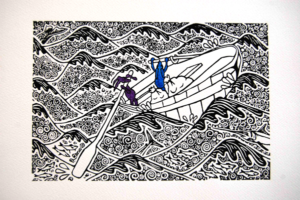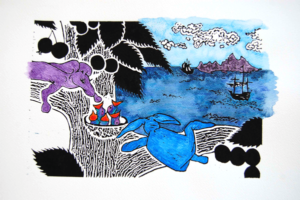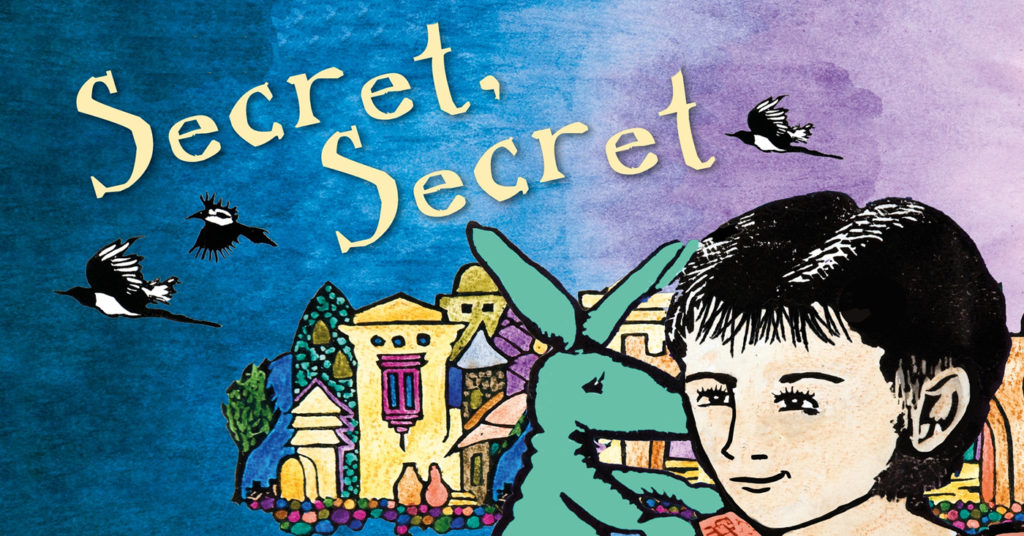In a child’s mind, keeping secrets can be exciting, as well as a huge burden. It may not always be clear to them what’s a good secret; what’s a not so good secret; and what’s definitely not to be kept a secret. In her new book, Secret, Secret, Daisy Law explores the different types of secrets children may have, and encourages them to feel confident to share their secrets. In this blog post, Daisy explains why she believes this is an important lesson that children must learn.
I wrote Secret, Secret to be one possible simple solution to a range of really complex problems affecting the safety and wellbeing of children. Most social workers, teachers and people in the caring professions would advocate early intervention wherever there is abuse or neglect blighting a child’s life, but unfortunately it can take many years for individuals to speak up and access the help available.
It seemed to me that kids needed a kind of mantra which might help them find their own voice and be heard. The dynamics of an abuser’s use of coercion, threats and control often prevents children disclosing harm they’re suffering. If the abuser is a family member, then they usually set the tone of what’s ‘normal’ or acceptable and the child is powerless to even know that what’s being done to them is wrong. So I set myself the task of writing something which could help children map their own feelings about anything they felt forced to keep secret.
 Fun had to be first on the agenda, to engage children in a story. I felt that rhyme would help the message bounce along, and it also helps kids remember the words even when they don’t have the book in front of them. This was especially important for pre-schoolers and non-readers. I worked as a teacher for many years and tried to think about the literacy aspects which would mean teachers could use Secret, Secret for group reading or other aspects of school and nursery curriculums, so that children have the message reinforced. I also knew how difficult it can be covering safeguarding issues within PHSE or circle time, so I used open-ended questions to close the book. This invites a response from anyone reading or listening.
Fun had to be first on the agenda, to engage children in a story. I felt that rhyme would help the message bounce along, and it also helps kids remember the words even when they don’t have the book in front of them. This was especially important for pre-schoolers and non-readers. I worked as a teacher for many years and tried to think about the literacy aspects which would mean teachers could use Secret, Secret for group reading or other aspects of school and nursery curriculums, so that children have the message reinforced. I also knew how difficult it can be covering safeguarding issues within PHSE or circle time, so I used open-ended questions to close the book. This invites a response from anyone reading or listening.
As much as we may all want to end abuse, we don’t want to rob anyone of their innocence. Bearing this in mind, I wanted the text and illustrations to make subtle references to the kinds of fears, anxieties and experiences which some children might have. Trauma alters your thinking processes and makes your body feel different, so I filtered all my professional understanding of psychological and physiological responses to focus on the notion of ‘stone-cold’ insides.
I also sought to create an almost real world – similar but not quite this world, so that children could enjoy a safe level of removal. The toys, or Dust Bunnies, Lilac and Little Blue were key for this. Kids know how to talk to a toy, and there’s often a freedom in telling your darkest secrets to an imaginary friend. The threat of the faceless pirate can be a game, or it can represent how menacing adults can be to a child living in fear. Along with a bit of light relief fart humour with a whoopee cushion, this means that children can interpret and rationalise both the text and illustrations to fit their own life. So bottoms, beds, closed doors, fear, guilt, shame, and threat all feature subtly and can communicate to the subconscious, but happiness, joy, adventure, wonder, achievement and pride are there too. Parents who may be less confident discussing the potentially tricky area of disclosure can also help their children think about whether to ‘keep or tell’ secrets. This makes Secret, Secret a lovely bedtime read – especially as kids like to join in with the rhymes.
The illustrations were all hand carved in lino and then hand printe d and coloured. I wanted to create a ‘folk art’ style set of strong images which might not date too readily. The magpies allude to the old folk rhyme and allow another way of thinking about how children might be bullied into believing some secrets are ‘never to be told’. Magpies are noisy too – they have found their voice. A whole year goes by from the stark bare trees and closed doors of the first page, to the warm embrace of acceptance at the end – with the snowdrops as a symbol of hope even in the depths of winter.
d and coloured. I wanted to create a ‘folk art’ style set of strong images which might not date too readily. The magpies allude to the old folk rhyme and allow another way of thinking about how children might be bullied into believing some secrets are ‘never to be told’. Magpies are noisy too – they have found their voice. A whole year goes by from the stark bare trees and closed doors of the first page, to the warm embrace of acceptance at the end – with the snowdrops as a symbol of hope even in the depths of winter.
My hope is for kids to find their voice and a sense of hope from Secret, Secret so that it’s an important step on their journey.
Daisy Law has over 17 years’ experience as a teacher of English and literacy. As a teacher, she has been trained in safeguarding and understands the importance of children being able to disclose secrets. She lives in France with her children, who teach her about being young, happy and full of enthusiasm for exploring the world.
£9.99
Available now!

